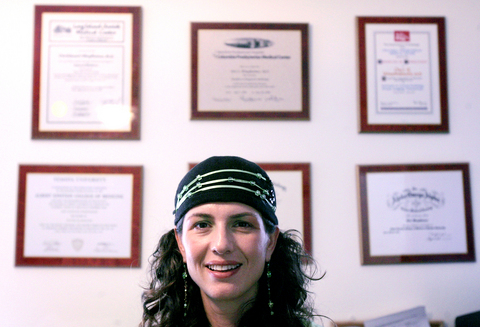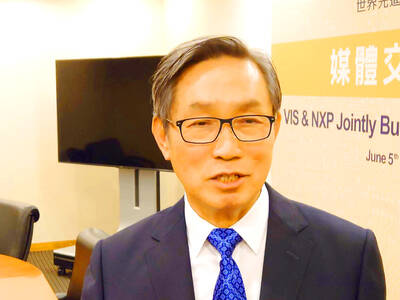Dr Orit Wimpfheimer rolls out of bed in her home in Israel each morning, walks downstairs and reports to her job -- on the East Coast of the US.
Wimpfheimer, an Ivy League-trained radiologist, analyzes test results from US hospitals over the Internet. She is among a growing number of American Jews who immigrated to Israel because they were able to earn a US paycheck and enjoy a lifestyle few Israelis ever see -- thanks to e-mail, Internet and video-conferencing.
"You get to move to the country of your choice. You get to do what you did before in the comfort of a home office," said Wimpfheimer, who lives in the Jerusalem suburb of Beit Shemesh.

PHOTO: AP
Lack of high-paying jobs has been a major obstacle for potential immigrants to Israel from the US and other wealthy countries. Unemployment in Israel hovers around 9 percent, and Israeli professionals typically earn a fraction of what their counterparts make stateside.
A few thousand Americans immigrate to Israel each year, a tiny percentage of the more than 5 million Jews in the US. But the number has grown in recent years, in part because people can bring well-paying jobs with them, said Daniella Slasky, director of employment at Nefesh B'Nefesh, a nonprofit agency that helps North American Jews move to Israel.
"I wouldn't say this is the reason for increased aliya," said Slasky, using the Hebrew word for Jewish immigration to Israel. "I think this is a tool that helps people move to Israel. It is much easier to make aliya, coming here and knowing you have a job. Also, having the American salary while living here is very significant."
She estimated that 20 percent to 30 percent of the breadwinners among the new arrivals from North America maintain jobs overseas. When Nefesh B'Nefesh began work four years ago, the number was negligible, she said.
Among those keeping US jobs are medical professionals, accountants, lawyers, graphic designers and computer programmers. All do most of their work in Israel, though some periodically commute to offices overseas.
STAYING ON
When Adam Lubov, a database administrator, decided to immigrate in late 2004, the medical software firm where he worked in Savannah, Georgia, asked him to remain on board. Since he already did most of his work from home, the transition was easy.
"I thought this was great. I can continue in my job, then look for something else," he said.
After he saw what he would earn in the local market, however, he decided to stay on.
"Seeing the pay difference, I can't do it," said Lubov, 28, who lives outside Tel Aviv.
Joel Pomerantz, a psychologist at an alternative school for at-risk children in Cleveland, supervises a team of five people from his home in Beit Shemesh. He checks into work about 3pm and works through midnight -- corresponding with the business day in Ohio.
Using the Internet, he can review results of tests administered by colleagues, prepare reports or enter information into a database. He meets regularly with parents and students via video-conference.
Pomerantz said the setup has been a natural fit for his school, called the Virtual Schoolhouse, which uses Internet learning to augment classroom activities. He said his tech-savvy boss suggested the arrangement, and he spent several months preparing before moving with his wife and three children in July.
While the distance has created some obstacles, Pomerantz, 31, said it has also yielded some benefits. Many parents are enthralled with the technology, and he has become more efficient because there are fewer distractions here.
"So far so good. I foresee this going really well," he said.
SACRIFICE
Some of the arrangements require creativity and sacrifice. Shye Wortman, an internist who moved to Beit Shemesh last year, still flies to New York every two weeks to treat patients.
When in Israel, he reviews charts and test results and speaks to patients by phone. Using Internet phone service, he even maintains a New York phone number.
"Some patients don't know I'm in Israel," he said.
Despite the travel, he says he now has more time with his family than he had in the US.
In other cases, the seven-hour time difference with the eastern US can be an asset.
Wimpfheimer, the radiologist, works from 6am to 3pm, teaming with two partners to cover the overnight shift at 18 hospitals in the northeastern US.
She reviews CT scans, MRIs and ultrasounds and exchanges information instantaneously over secure Internet connections.
The arrangement benefits the hospitals, which don't need to hire an overnight crew or force doctors to be on call during the bleary-eyed graveyard shift.
"It works much better," said John Breckenridge, chairman of the radiology department at Abington Memorial Hospital in Abington, Pennsylvania. "They're awake and alert."
And thanks to real-time technology, the distance isn't an issue.
"She could be in the next room. It really doesn't matter," he said.
Wimpfheimer, 36, a mother of six, can spend the afternoons with her children. With her US salary, she can live comfortably in a three-level suburban house with a swimming pool.
"The business is growing. We're having fun doing it," said Wimpfheimer, who immigrated from New York four years ago. "I wouldn't even consider moving back."

TARIFFS: The global ‘panic atmosphere remains strong,’ and foreign investors have continued to sell their holdings since the start of the year, the Ministry of Finance said The government yesterday authorized the activation of its NT$500 billion (US$15.15 billion) National Stabilization Fund (NSF) to prop up the local stock market after two days of sharp falls in reaction to US President Donald Trump’s new import tariffs. The Ministry of Finance said in a statement after the market close that the steering committee of the fund had been given the go-ahead to intervene in the market to bolster Taiwanese shares in a time of crisis. The fund has been authorized to use its assets “to carry out market stabilization tasks as appropriate to maintain the stability of Taiwan’s

STEEP DECLINE: Yesterday’s drop was the third-steepest in its history, the steepest being Monday’s drop in the wake of the tariff announcement on Wednesday last week Taiwanese stocks continued their heavy sell-off yesterday, as concerns over US tariffs and unwinding of leveraged bets weighed on the market. The benchmark TAIEX plunged 1,068.19 points, or 5.79 percent, to 17,391.76, notching the biggest drop among Asian peers as it hit a 15-month low. The decline came even after the government on late Tuesday authorized the NT$500 billion (US$15.2 billion) National Stabilization Fund (國安基金) to step in to buoy the market amid investors’ worries over tariffs imposed by US President Donald Trump. Yesterday’s decline was the third-steepest in its history, trailing only the declines of 2,065.87 points on Monday and

TARIFF CONCERNS: The chipmaker cited global uncertainty from US tariffs and a weakening economic outlook, but said its Singapore expansion remains on track Vanguard International Semiconductor Corp (世界先進), a foundry service provider specializing in producing power management and display driver chips, yesterday withdrew its full-year revenue projection of moderate growth for this year, as escalating US tariff tensions raised uncertainty and concern about a potential economic recession. The Hsinchu-based chipmaker in February said revenues this year would grow mildly from last year based on improving supply chain inventory levels and market demand. At the time, it also anticipated gradual quarter revenue growth. However, the US’ sweeping tariff policy has upended the industry’s supply chains and weakened economic prospects for the world economy, it said. “Now

Six years ago, LVMH’s billionaire CEO Bernard Arnault and US President Donald Trump cut the blue ribbon on a factory in rural Texas that would make designer handbags for Louis Vuitton, one of the world’s best-known luxury brands. However, since the high-profile opening, the factory has faced a host of problems limiting production, 11 former Louis Vuitton employees said. The site has consistently ranked among the worst-performing for Louis Vuitton globally, “significantly” underperforming other facilities, said three former Louis Vuitton workers and a senior industry source, who cited internal rankings shared with staff. The plant’s problems — which have not